The Miracle Vine
The story of kudzu.
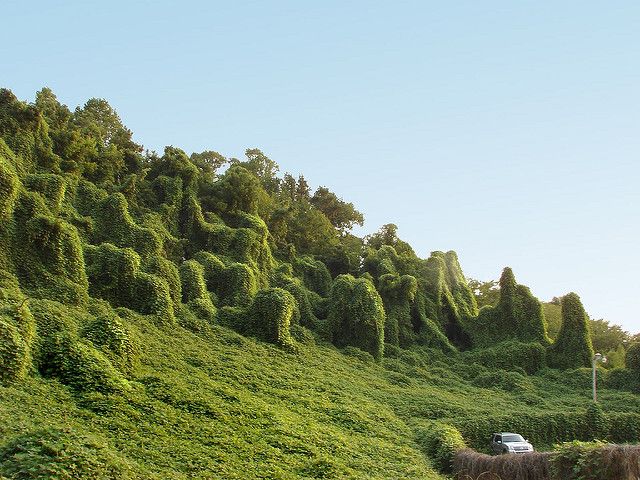
Image: Katie Ashdown via Flickr
In Georgia, the legend says
That you must close your windows
At night to keep it out of the house.
The glass is tinged with green, even so.
—“Kudzu,” James Dickey
At the 1876 Centennial Exposition in Philadelphia, Alexander Graham Bell revealed his telephone to the world. The Sholes and Glidden company displayed the first Remington typewriter, Heinz launched its ketchup, and Charles Elmer Hires introduced Root Beer. There were over two hundred structures housing 30,000 exhibitions including elephant-sized cannons, a 1,400-horsepower steam engine, and the right arm of the Statue of Liberty. But according to the journal American History, the exhibit that drew the most “ooohs” from the cosmopolitan crowd of ten million was a garden display of a fast-growing Japanese vine. With leaves the width and shape of a human palm, the evergreen produced conical clusters of spring flowers that were the color of plums and smelled like red wine. As of today, kudzu has spread to 32 states and Canada.
It is called the foot-a-night vine, the cuss-you vine, the vine that ate the South. It has leapfrogged the Rockies and taken up home in Washington and Oregon. An end-of-the-millennium issue of Time Magazine in 1999 called kudzu’s introduction one of the hundred worst ideas of the twentieth century, along with Prohibition, telemarketing, DDT, and “The Jerry Springer Show.” Yearly estimates for kudzu costs in the United States range from $50 to $500 million in lost crops and control methods, increasing around $6 million a year.
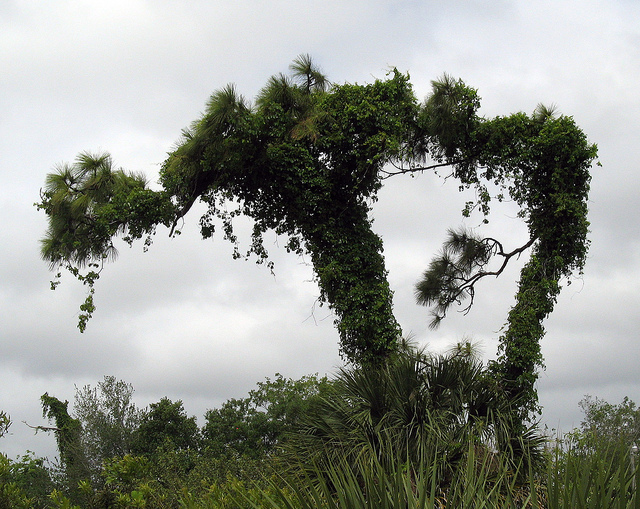
Image: Greg Goebel via Flickr
People in the South report parking cars and not being able to find them, later uncovering the vehicles from garages of vines. Kudzu has covered railroad trestles so thickly that freight trains have been derailed. The walking leaves wrap around utility poles and bring down power lines, snuffing lamps. It roams empty lots in Florida, props up mailboxes, swims in unused pools. Kudzu blankets cars and trees indiscriminately. It dominates even Spanish moss, the other notable greenery draped over everything else in the south. It wraps so tightly that it mummifies, killing plants, thousands each year, not by constriction, but by shutting out the sun. When an unmolested vine crests over a copse of trees, the shapes it makes are like prehistoric creatures that once roamed the swamp. These are called “Kudzu Monsters,” and they can be found all over Florida, peering into widows, severing the connections of utilities, and disappearing into shadow.
![]()
Because of kudzu’s success at the Philadelphia Centennial Exposition, it was showcased at other expositions, including the Chicago World’s Fair, where Charles and Lillie Pleas of Chipley, Florida saw the same presentation and learned the vine could grow almost anywhere. It was drought tolerant, heat tolerant, frost tolerant; it could thrive in the barest of soil. What better place to grow it, they thought, than in the eroded, beaten, spat upon hillsides of north Florida. They could feed it to livestock while it revitalized their earth.
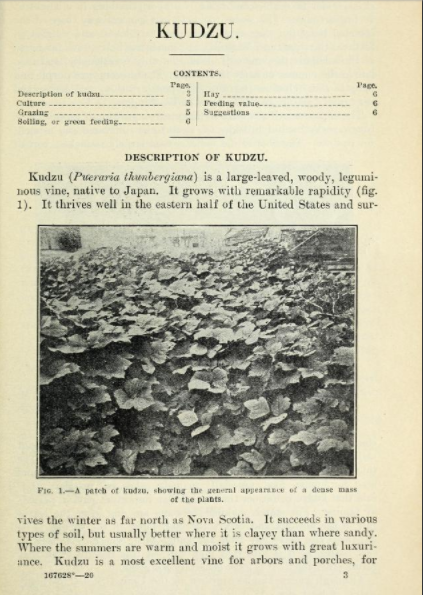
The Pleas planted the vine on their land in Chipley, and the legume thrived, slinking up their front porch and curling around their bench. They sold seeds by mail-order catalogue, and their claims of the vine’s swiftness and long-suffering robustness led to an investigation for fraud. Postal Service authorities drove to Chipley, and, at the Pleas’ property, ran their eyes over a 35-acre field of vermillion hands waving in the breeze. The farm had once swept away, but now livestock were nuzzling the dense, vine carpet. The claims about the vines were honest, the Postal Service decided, and they dropped the charges.
Kudzu’s greatest champion was Channing Cope of Georgia. A heavy-set man, an alcoholic, and a fan of suspenders, Cope was a self-proclaimed front porch farmer. He was a merchant marine, then a press agent, a lawyer, and then in 1927, he settled down and bought a run-down 700 acres in Covington, south of Atlanta, and named it the “Yellow Farm.” The land was so ravaged that the county agent, who surveyed it with Cope, said that he would, “perish to death” trying to make a living. While this may have unnerved him, when he heard about kudzu’s uninhibited growth, that his erosion-savaged farm could be saved by a vine, Cope believed front porch-corralling possible. Because of kudzu, Cope believed farming life could be easy. With a telescope and electronic switches to open cattle pens, he wrote in his book, Front Porch Farmer, a “farmer could run his land from an easy chair.”
Because of his media savvy in print and radio, Cope was able to discuss his farm on his weekly radio show on Atlanta’s WCON. On air, he was sometimes drunk, and spoke clearly if flamboyantly—a Howard Stern of the Depression. He was also the editor of the Atlanta Constitution, a newspaper that had a circulation of almost 200,000. In his daily column, “Channing Cope’s Almanac,” he wrote about the ills of things such as land erosion, barbershop quartets, his dead dog Mr. Burns, and, ironically, alcoholism.
He became known as the “Kudzu King” or the “Kudzu Kid,” as Time Magazine called him in a 1949 profile. (The same story called him “fat” and reported that he spiked his morning coffee.) Cope started the Kudzu Club of America—it had 20,000 members by 1943—which met annually and had contests to see who could plant the most vines. Each year, they elected a bright and beautiful Kudzu Queen. Cope also hosted various government and foreign officials, and he encouraged and provided for the planting of kudzu by poor farmers, and the United States government soon followed suit. The Civilian Conservation Corps and the Soil Conservation Service planted some 100 million vines on road banks and public lands.
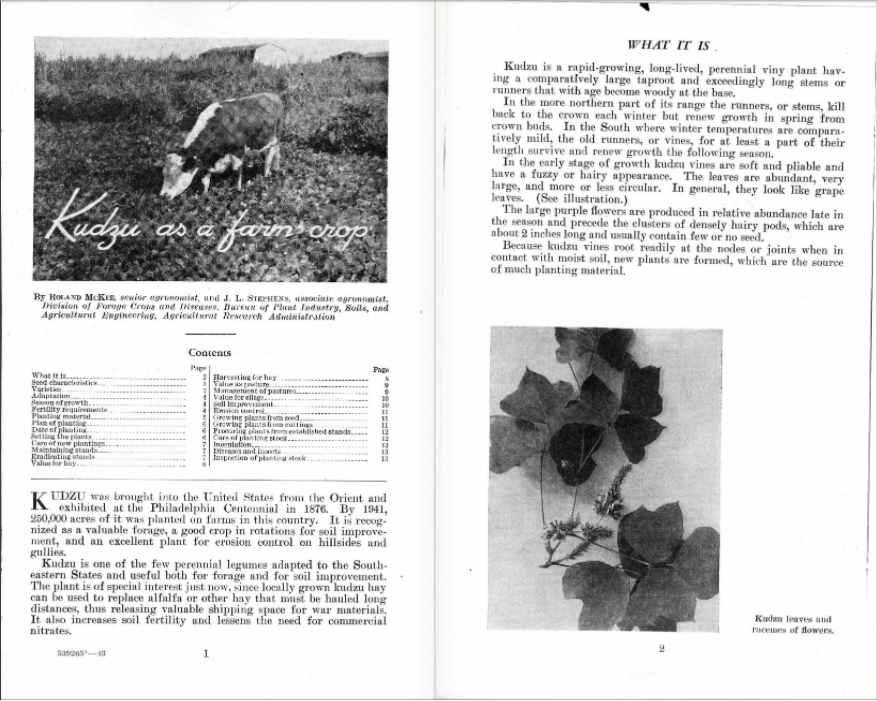
Each week, on Wednesday at 4:30 p.m, Cope would eloquently, humorously, and voraciously champion kudzu on his radio broadcast from the creaky floors and big swing bench on the Yellow Farm porch. His editorials in Atlanta’s newspapers also helped kudzu’s cause, and they were reprinted in Business Week, Reader’s Digest, and Gentleman Farmer. He became Georgia’s “Conservation Man of the Year” in 1945. The same year, he and his wife answered 3,000 fan letters. Cope knew kudzu was pernicious; he received mail every month from people also asking him how to get rid of it. But Cope stood by his position; the ground was disappearing, after all. “Our position,” Cope wrote, “is in some respects like that of the physician who discovers that his patient is suffering from a malignant fever, say malaria. He does not prescribe warm baths and massage and manicures and hairdos and soft music. He produces his arsenic and quinine and atabrine and his frightening hypodermic needle and goes to work.”
Besides preventing erosion by clinging to the soil, Kudzu does has a variety of uses. It can be dried and its rubber-like vines can be woven into baskets, lanterns, wreaths, and a host of other household flotsam. Some people mash kudzu into soap. Others make kudzu shampoo and kudzu whipped body mousse. You can make jelly with kudzu. Some Southerners erect kudzu Christmas trees. Cows love it. Sheep will munch on it, as will goats. It is a legume, like a pea, so it fixes nitrogen into the earth. Scientists at Harvard think they may have stumbled on a drug made from the vines that could cure alcoholism. Already, Amazon shoppers can buy supplements made from ground kudzu, vitamin bottles advertising “liver support,” “anti alcoholism,” and “liver tonic.” It is edible, nine percent protein. The Japanese tend to dry it, grind it, and use it to make a Jello-like pudding called “Kuzumochi.”![]()
Aside from all its uses, Kudzu seems to be fitting in. It has taken on a distinct Southern appeal—Gothic, because it swims well with the idea of something taking over. At the Colonial Restaurant in Chipley, Florida, where kudzu was first cultivated in North America by the Pleas, a “Southern-style” buffet includes corn bread, mashed potatoes with cream gravy, fried chicken, collard greens, and iced tea. Corn is from Central America, and potatoes are from Peru. Chicken and black tea from China. The gravy’s cream is a product of cattle domesticated in the Fertile Crescent. The Colonial Restaurant’s table sugar was derived from sucrose, a practice developed in Ancient India. Collard greens are probably Brazilian. The result is foreign and native, unnatural and cultural. Diners at the Colonial Restaurant (many of European heritage) soak up this Southern sense of normalcy. They swallow and sip and chew, perhaps unknowing that at that moment something unstoppable is lurking in the places they forgot to check—the basement, the window sill, atop the very oaks that shade the Colonial Restaurant. The monster, which is people unleashed—how we’ve made the world—is there, ready to envelop them.
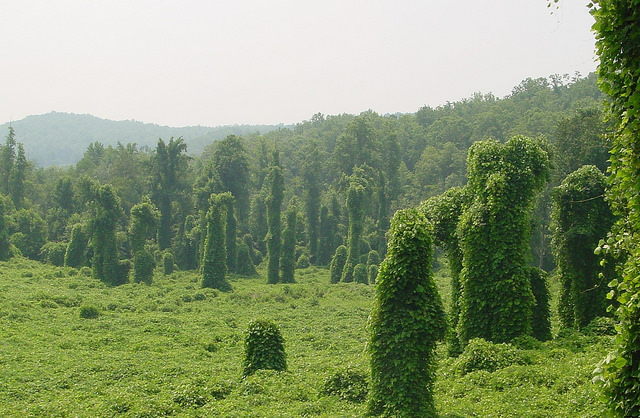
Image: U.S. Department of Agriculture via Flickr
Cope hung onto the idea of his miracle vine, even when he began hearing reports of “out of control” vines and when the government stopped recommending its planting. When he became older, a constant alcoholic, and kudzu was delisted from the USDA’s recommended conservation plants, he refused to clear out the tangles that were then spreading out from his land. It covered neighbors’ trees and crowded the road. In 1976, the people who bought Yellow Farm found that kudzu had “devoured” the land as well as Cope’s house. The vine had enveloped its owner and all of his life. The miracle vine had crept, night by night, inch-by-inch over Cope’s driveway, until one day the way out was shielded from sight. With so much kudzu cover, teenagers took it as an opportune time to drive into Cope’s fields, party and make love underneath the leaves.
Cope came one night to run them off. He took three steps, stepping off his front porch, where he’d broadcasted for decades, took three steps to chase the hooligans from his Once-Yellow-Now-Verdant Farm, prevent their uncouth behavior among his vines, the alcohol kudzu could have fought years later in pill form saturating his blood, thirty years of his life now deemed “undesirable,” he who built the ecological monster, took three steps and died of a heart attack, and fell among the leaves like hands, waiting to catch.
